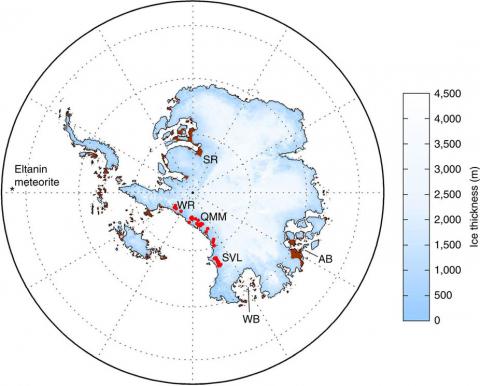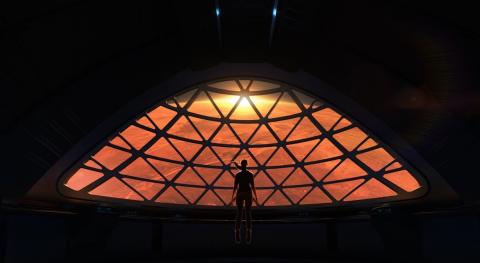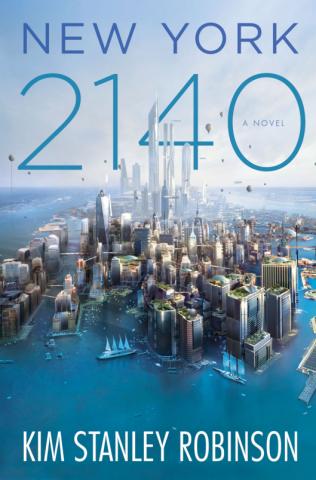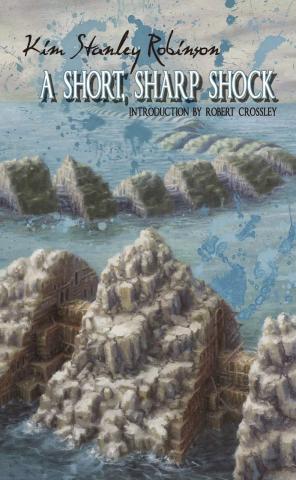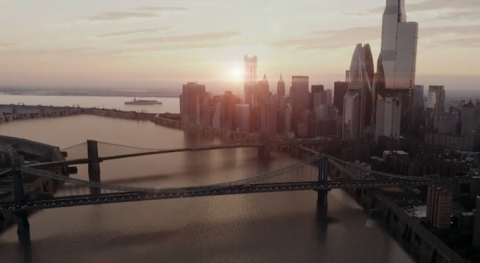Utopia in the long run + Next next novel tease
Submitted by Kimon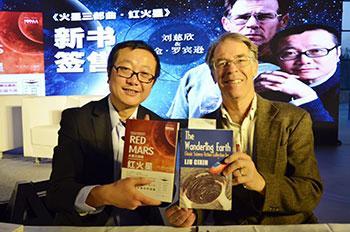
Earlier in December, Kim Stanley Robinson recently was in China to discuss the theme of utopia and to promote a new edition of Red Mars in Chinese by Beijing Alpha (Chongqing Publishing Group)! KSR celebrated the 500th anniversary of Thomas More's Utopia in Beijing Normal University -- see this clip, where he talks of the Chinese/Uygur chapter of The Years of Rice and Salt, Widow Kang. With Beijing Alpha he also appeared with Chinese SF author Liu Cixin (famous for his Three Body Problem trilogy, which KSR has called "the best kind of science fiction" on the English translations), with simultaneous aural and written (!) translation of their live Q&A and a live internet stream followed by tens of thousands. Both are pictured here, from this report from the event. Perhaps Chinese speakers can share more content? The internet spheres are not very well connected yet...
Anyone following long history trends can perceive that the future of humanity will be more and more defined by Asian affairs (estimates of "the West"'s share in world GDP looks more and more like a 500 year parenthesis fuelled by it being the first in the technological revolution, but that gap is closing). So it will come as no surprise that, after New York 2140 in 2017, KSR's next novel will focus on China and close space (moon) colonization!
In the meantime: No matter what, climate change is happening. It's all a matter of us accepting reality, and adapt and change as a consequence.
This is Kim Stanley Robinson's keynote speech for the 2015 Bioneers Annual Conference (from October 2015). Climate change, science and politics, social organization and laws, history and utopia: in 20 minutes, you have a powerful, convincing, and -- also judging by the cheers and applause from the crowd -- very energizing condensation of everything KSR!
The coming century requires that we rethink and restructure our relationship with our planet to avoid endangering the integrity of the biosphere and risking the end of human civilization. This means reforming our economic system, which uses a market and trade system that systemically under-prices and degrades both people and the natural world. How can we change that, and what would it look like if we did? One of the great visionary science fiction writers of our era will draw from his decades of work and thinking on this question to sketch a utopian but deeply informed and cogent scenario of a new economy for the coming decades. Introduction by J. P. Harpignies, National Bioneers Conference Associate Producer.
Another essential KSR resource is this one-hour conversation with him for The Conversation podcast. The discussion is very wide-ranging, tackling economic, scientific, ecological, social, cognitive, anthropological, and more, themes.
Some additional links to panels and interviews:
An extended version of the Bioneers speech above can be found here, at Utopian Dreaming: 50 Years of Imagined Futures in California and at UCSC (from November 2015). KSR talks about utopian novels, and how they tried to envision the transition from the world of today into a utopian future, for example his own Pacific Edge, or Ernest Callenbach's Ecotopia (which saw the Pacific coast states seceding from the United States and forming their own ecological utopia), which celebrated its 40th anniversary. He goes on to imagine an updated close-future history involving student debt, banking assets, private/public ownership and social movements!
Here's a short interview around the event.
"It's been 35 years since the Reagan and Thatcher conservative regimes and the effect has been bad environmentally and socially. But I think there are good things too." Grim dystopian visions make for more dramatic movies, he said, and utopian ones are more low-key. "There's always going to be hope," he said. "It's always stubborn and persistent, even if it's more subtle."
And a blog post about another event around the same time.
Another podcast with KSR tackling environmental and sustainability issues comes from Generation Anthropocene, from the Smithsonian magazine.
Climate One hosted an event on the emerging genre of Cli-Fi, discussing with KSR and Jason Mark, editor of the Earth Island Journal. The audio recording of the event and transcript are online (Edit: also at PRX).
There used to be bumper stickers that said keep the U.S. out of Ecotopia. And there are things were just being done in an environmentally conscious way with the best technology of the 1970’s and it was a very inspirational book. It changed people's lives, it changed their thinking. I think what it was, was the ‘60s generation was growing up in thinking how do I live my ideals how do I take care of my kids? So you get these Ecotopian thinking. But then the ‘80s came and Ecotopia didn't know about the ‘80s. It didn't know about the Reagan-Thatcher counterrevolution and the incredible amount of the growth of globalization and late capitalism. So now Ecotopia looks a little bit quaint. But on the other hand the ideas are still very strong and the book should have a nice 40th anniversary.
[Interstellar] I really disliked it. [...] it was as if the filmmakers were saying if -- since this is a science fiction movie we can be stupid and get away with it because it's just science fiction. And so I was offended by it because science fiction is actually a very intellectually powerful genre and it doesn't have a whole lot of patience for stupidity. So this is like a kind of 1930’s power fantasy movie and we’re well past that now, we’re 80 years past that kind of thinking. [...] I thought WALL-E was a masterpiece.
[Writing and reading books] For a while there you're living other people's lives, you're paying attention to it with an empathy. [..] People are very sophisticated that and they even are pretty good at giving the political orientation of the work of art that you can unpack all that stuff you can decode it very quickly. But it's also put into everything else that you experienced, and then it becomes one more datum you've lived one more life. That's the magic of art. You’ve managed to pack in one more of your 10,000 lives by reading another book, by seeing another film.
[Science of climate change] I've had this impression that the scientific community has been shocked. That around 2002 they raised their hand, they said folks, world, the biosphere is burning down something needs to be done. And they were ignored. And capitalism just rolled on saying we need profits, we need shareholder value [...] And now I think in the last five years or so you’ve see more and more scientists and more and more scientific organizations trying to make something more vigorous than raising their hand at the back of the room and saying we've got a problem. It's an ongoing situation and it would be interesting to see what happens.
[GMOs] I think when people are objecting to against GMO foods is not that the foods have been manipulated, the plants have been manipulated, but that the seeds and the genes are then owned by a company. So what you're objecting to is not science but capitalism. And this happens a lot. A lot of anti-science, especially from the left, in America is an objection to ownership of the public good and so it’s an objection to capitalism not an objection to science. And if you de-strand those two you begin to see this big cosmic battle, at least I do, in which the science is a force for trying to understand the world and make it more comfortable and better balanced with nature and capitalism is strip mining for private profit of the one percent as it’s practiced now and it's basically been its historical role all along.
[The world since 2008] Anybody making more than $100,000 a year is actually going into unhappy land rather than happy land according to scientific studies, so nobody needs to complain about this. It's a perfect plan, it’s something we can all do. It’s a political program right? And it’s now within the window of acceptable discourse. If I said this 10 years ago you would say, oh my god these hippie science-fiction writers, you know, they’re just so crazy and it is true, but now it's within the window of acceptable discourse.
Another of KSR's novels trying to imagine the transition from today to a near-future environmentally-friendly tomorrow is Green Earth (the omnibus of the Science in the Capital trilogy). Written during the Bush Jr. years and envisioning who would come next, it has suddenly become relevant again. In this letter to readers (written before the elections...), KSR talks about the process of updating his trilogy into one volume:
Looking back at this novel ten years later, I am pleased at how it holds up. Of course with the passage of time it has become a very weird mix of historical novel, contemporary realist fiction, and near-future science fiction, plus a healthy dose of political fantasy. I hope this melange of temporalities adds to its interest as a reading experience now, as readers play the game of seeing what was wrong and what was right, what has already happened and what is happening now, and what may still come. That’s always part of the entertainment with near-future science fiction; as with certain wines, there’s an aftermath when the taste of the vintage can improve.
I’m hoping that the passage of a decade has made this novel interesting in new ways. I think it still catches some of how Washington works, and how it feels to live an ordinary American life in our era.
With the advantage of hindsight I could see better what it needed, and as we have learned so much more about climate change, quite a few passages that once brought the news, didn’t any more. Also, in trying to be true to the way we live now, I wrote a lot of indoor scenes. As I condensed it I noticed that the outdoor scenes could be left untouched, but many indoor scenes could be squished with happy results. Same with our lives! Ultimately I cut about fifteen percent; the exercise was good for me, and for the book. Many, many thanks to Jane Johnson and Anne Groell for giving the chance to do it.
In this interview for Slate.com, KSR talks about geoengineering and how it was featured in his fiction
“It’s so new,” he told me, that we feel “we’re sure to fuck it up.” The aura of fatalism that hovers around climate change more generally further illuminates this popular skepticism. While we are, as Robinson put it, “just now coming to grips with the climate change problem more generally,” those who have long paid attention often fear that we’ve already gone too far to pull back from the brink. In this regard, the very plausibility of geoengineering may be its undoing. We need a miracle if we want to make a real difference, the thinking goes, but there’s nothing especially miraculous about most geoengineering proposals. To the contrary, most of them comprise large-scale applications of basic scientific principles and processes, meaning that for many they tend to feel inadequate at best. In this regard, Robinson noted, geoengineering proposals may also pose a moral hazard, since they potentially pull focus from more difficult endeavors like promoting universal decarbonization.
KSR and NASA scientist Chris McKay were featured in the documentary "BLUESPACE" by director Ian Cheney, which premiered in November 2015. See the trailer here.
Kim Stanley Robinson was the judge in the New Scientist's 2014 Pitch Us a Movie Competition. The winner was Matt Wilkinson -- but no news since then.
He’ll be working on The Sky Runner, his science fiction story set on, or rather under Europa, with help from a room full of writers and industry professionals including Christopher Priest, Liz Jensen and Louis Savy.
KSR supported the crowdfunding campaing for Mars Trac by donating autographed copies of his books.
Building on Mars with Mars Trac, the Open Source Construction RoverA multi-disciplinary group at Arizona State University adapting Open Source Ecology's LifeTrac vehicle for Mars."Thanks for supporting open hardware on the space frontier! Stan 2013"
In 2014, KSR discussed the life and writings of John Muir at a lecture series on Environments in Motion: Understanding and Protecting Our Planet, at Muir College (UCSD). Muir's writings about Sierra glaciers, which changed the prevailing scientific notion, were characterized by a rare combination of technical precision and spiritual passion. Muir founded the Sierra Club and and was one of the world’s first environmentalists. He undoubtedly influenced Roosevelt’s decision to create a system of national parks. Stan:
“I love the Sierras and spend a lot of time hiking there. Many of the descriptions in the books of my Mars Trilogy are taken directly from my experience in the Sierras.”
The Clarion Science Fiction and Fantasy Writers' Workshop is held annually (six weeks, summer) at the University of California San Diego since 1968; KSR has been both a student and an instructor. KSR is the Clarion Foundation Vice President. The workshop became an affiliate program within UCSD's Arthur C. Clarke Center for Human Imagination, created in 2013, an integrated research center where engineering, medicine, and the arts, sciences, and humanities explore the basis of imagination. The workshop almost closed shop because of lack of funding but it continues to exist via fundraising; most recently thanks to a large donation.
KSR lists his 10 favourite science fiction novels for Barnes & Noble (in order):
- Star Maker, by Olaf Stapledon
- Solaris, by Stanislaw Lem
- The Man in the High Castle, by Philip K. Dick
- The Left Hand of Darkness, by Ursula K. Le Guin
- The Female Man, by Joanna Russ
- Dhalgren, by Samuel R. Delany
- Sarah Canary, by Karen Fowler
- The Bridge, by Iain Banks
- The Book of the Long Sun, by Gene Wolfe (Nightside of the Long Sun, Lake of the Long Sun, Calde of the Long Sun, Exodus from the Long Sun)
- The Mount, by Carol Emshwiller
But because these top 10 lists are impossible, he offers 10 more!
And two interviews behind paywalls:
- "Science fiction’s warnings for the present" for High Country News
- Interview in SF & #cyberpunkNOW issue of the London Reader

